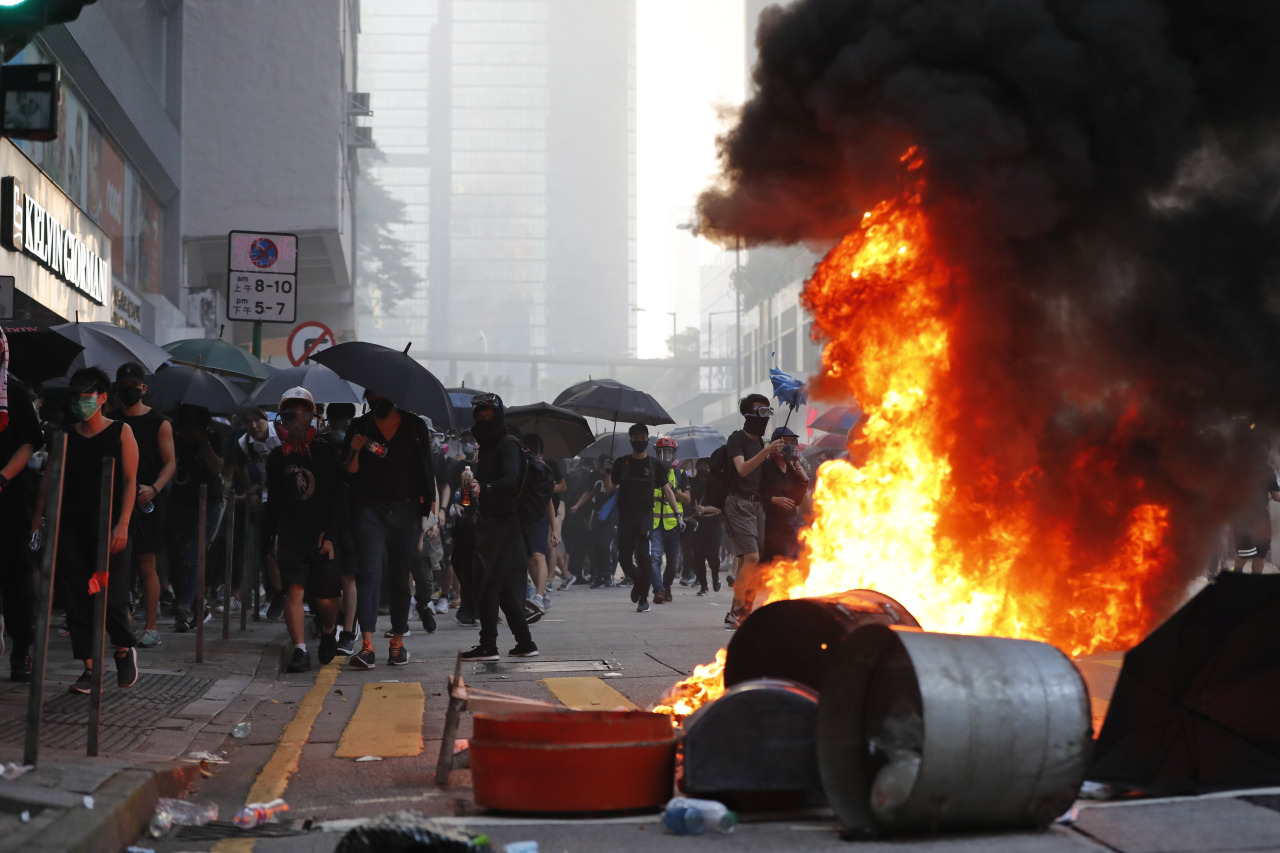HONG KONG, Oct 1, 2019 (AFP) - Hong Kong's pro-democracy protests erupted into violence in June, plunging the former British colony into its most severe crisis since it reverted to Chinese rule in 1997.
After more intense protests on Tuesday, the 70th anniversary of communist China's founding, here is a recap.
- First clashes -
In the semi-autonomous territory's biggest demonstration since 1997, more than a million people, according to organisers, march on June 9 to protest a draft government bill that would allow extradition to mainland China.
Violence erupts when pockets of protesters fight running battles with police.
A new demonstration on June 12 sees the worst clashes since the handover.
Police use tear gas, rubber bullets and batons against demonstrators.
Dozens are injured and one protester dies falling from a roof.
- Two million protesters -
Hong Kong leader Carrie Lam suspends work on the bill on June 15 but a demonstration the next day calls for its full withdrawal.
Organisers say two million people take part in a city of 7.3 million.
On July 1, the anniversary of Hong Kong's return to China, hundreds of protesters smash their way into parliament and ransack the building.
- Authorities get tough -
On July 21, masked, stick-wielding government supporters -- suspected to be triad gangsters -- beat protesters in a train station.
July 27 and 28 see running battles between riot police and protesters.
After more intense protests on Tuesday, the 70th anniversary of communist China's founding, here is a recap.
- First clashes -
In the semi-autonomous territory's biggest demonstration since 1997, more than a million people, according to organisers, march on June 9 to protest a draft government bill that would allow extradition to mainland China.
Violence erupts when pockets of protesters fight running battles with police.
A new demonstration on June 12 sees the worst clashes since the handover.
Police use tear gas, rubber bullets and batons against demonstrators.
Dozens are injured and one protester dies falling from a roof.
- Two million protesters -
Hong Kong leader Carrie Lam suspends work on the bill on June 15 but a demonstration the next day calls for its full withdrawal.
Organisers say two million people take part in a city of 7.3 million.
On July 1, the anniversary of Hong Kong's return to China, hundreds of protesters smash their way into parliament and ransack the building.
- Authorities get tough -
On July 21, masked, stick-wielding government supporters -- suspected to be triad gangsters -- beat protesters in a train station.
July 27 and 28 see running battles between riot police and protesters.

The local authorities and Beijing toughen their stance and dozens are arrested.
On August 5 a strike brings the city to a standstill. For a third night, police confront protesters.
- Airport chaos -
Hong Kong's airport cancels flights on August 12 after being invaded by thousands of black-clad protesters.
On August 15 thousands of Chinese military personnel parade in Shenzhen, just across the border.
- First gunshot -
On August 25 police for the first time use water cannon and fire a warning shot after clashes in which protesters throw bricks and Molotov cocktails.
Several prominent democracy activists are arrested on August 30.
- Law shelved -
On September 4 Lam says the extradition bill is withdrawn. But the move is dismissed by activists whose campaign has broadened to demand greater democratic freedoms, police accountability and amnesty for the more than 1,000 arrested activists.
- Going abroad -
On September 8, activists march to the US consulate.
Leading activist Joshua Wong goes to Germany to rally support -- prompting an angry reaction from China -- and then to the United States.
On September 15, tens of thousands of people defy authorities for an unsanctioned rally. At Britain's consulate, they demand London's protection and that it ramp up pressure on Beijing.
- Violence intensifies -
On September 22, protesters rally inside a mall with some activists vandalising a subway station and defacing a Chinese flag.
Hong Kong's leader faces more than two hours of anger during a meeting with 150 of her critics for the first time on September 26.
September 29 sees the most intense confrontations in weeks. Police use tear gas, rubber bullets and water cannon against protesters hurling rocks and petrol bombs.
- Protester shot -
On October 1, police for the first time shoot a pro-democracy protester, leaving him wounded, during Hong Kong's worst unrest of the year. Tens of thousands of people defy police orders to disperse and running battles rage for hours across multiple locations.
Britain says the use of live ammunition is "disproportionate".
The new violence comes hours after China celebrated 70 years of Communist Party rule with a massive military parade. (AFP)
-
Articles by AFP




![[Herald Interview] 'Amid aging population, Korea to invite more young professionals from overseas'](http://res.heraldm.com/phpwas/restmb_idxmake.php?idx=644&simg=/content/image/2024/04/24/20240424050844_0.jpg&u=20240424200058)












![[KH Explains] Korean shipbuilding stocks rally: Real growth or bubble?](http://res.heraldm.com/phpwas/restmb_idxmake.php?idx=652&simg=/content/image/2024/04/25/20240425050656_0.jpg&u=)

